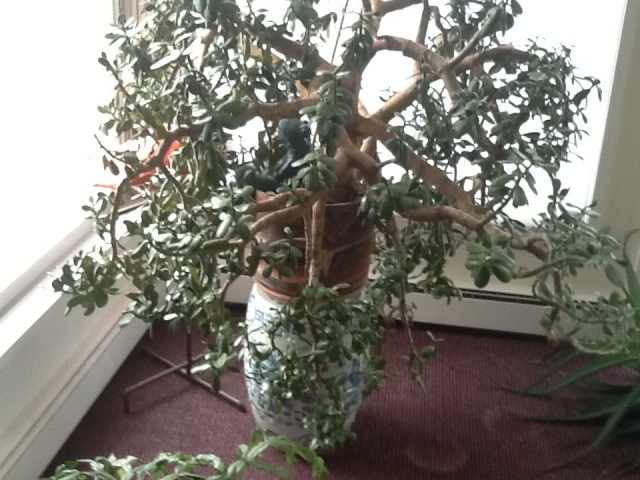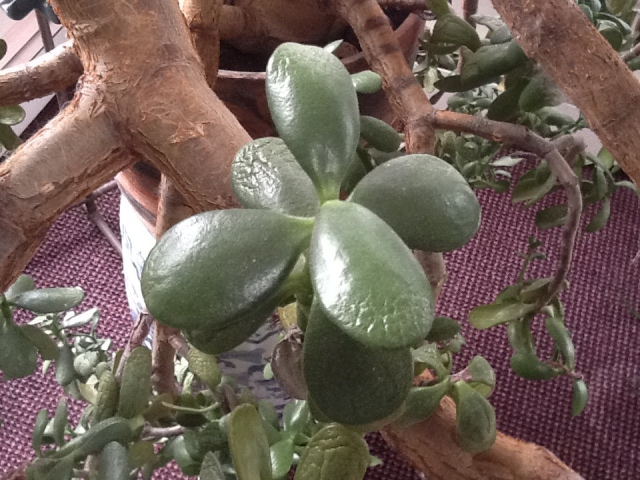Question
 #1
#1  #2
#2
I have a very old tree that has been in the same spot for almost 20 years.
It has flowered several times. Lately leaves have shriveled up and fallen. Leaves do not look nice and plump. White powdery substance falls when tree is shaken.
My watering habits have been the same. See photos. Is something wrong?
AnswerMichael,
Your watering habits should not always be the same. It the winter the plant should be watered only when it has been dry for 10 days. Ususally that means watering as little as once a month. These plants can retain high amounts of water in their body and are adapted to arid soil and climatic conditions, jade plants are indigenous to South Africa and is one of the most popular houseplants grown worldwide. Commonly called money plant, lucky plant and friendship tree, jades are evergreen plants and produces small white or pink flowers. The branches are thick, the leaves fleshy and rounded and they grow in opposite pairs.
Like all other plants, jade plant too is prone to diseases and some of the most common diseases are mealy bugs, black ring disease, powdery mildew and bacterial soft rot. These diseases are easily identifiable and can be cured if they are found at an early stage. Let's take a look at each of them and some measures which you can take to treat and prevent these diseases.
Mealy Bugs appear like cottony bits, mealy bug disease mostly effects the leaves and stems. The disease is caused by small mealy bugs, which suck the liquid in the leaves and stems, thereby damaging them. If left untreated, these bugs can destroy the plant and the best way of treating them is by rubbing a cotton swab dipped in alcohol over the leaves and stem. Alcohol kills the insect and removes any infestation which appears on the plant.
Black Ring Disease- If you find the underside of the leaves showing black rings, it may be due to black ring disease. Caused by a virus, the plant is not killed if infected by black ring disease. Till date no effective method have been discovered to treat this disease. The only way of preventing its spread is to remove the infected leaves. Moreover, make sure that you don't plant cuttings with infected leaves so as to prevent its spread.
Powdery Mildew- Powdery mildew is one of the most common jade plant diseases and can be detected by taking a look at the leaves. If the leaves appear to be scabby and becomes gray to dusty white, it can be powdery mildew, which is caused due to fungus attack. Over time, there would be distinct powdery, circular white spots and as they expand these spots would grow. Usually it's late in the growing season that the plant would be infected as the relative humidity and temperature are high, conditions ideal for the growth of the fungus. If the plant is attacked by this disease, the leaves, buds and fruits would show distorted growth and over time may kill the plant if left untreated. Premature leaf drop is another symptom of powdery mildew and before the leaves fall off they would become yellow in color.
If your plant is effected by powdery mildew, you need to apply some fungicide, but make sure that it can treat fungus attack in jade plant. You can go through the label and see if it would work or you may ask the store if the fungicide you intend to use can be used on jade plants. On your part, you can gather and destroy the fallen and diseased leaves, besides trying to reduce the relative humidity around the plants. Some of the fungicides which you can opt to use include products made of potassium bicarbonate, sulfur, lime sulfur and those which contain neem oil.
Brown Rot- Brown rot is another common disease and it's mainly due to over watering that the plant gets this disease. Before watering, you need to make sure that the soil has dried enough. As these plants can grow well in arid soil conditions, they are more susceptible to rot and so you just need to water them once a week when they are growing actively. On the other hand, when they are dormant, especially during the winter months, they need to be watered only once a month. There is no cure as such for rot, you can only prevent its spread. Cut the infected area with a sterile knife so that the disease does not effect the healthy tissues.
Use a fungicide such as sulpher powder which is available in hardware stores and garden centers to dust off the cut surface and if the infection has reached the roots, you need to cut off the infected roots and re-pot the plant in fresh soil. If the rot has severely damaged the plant, the only option you have is to take a cutting of a healthy portion and plant it in another pot as jade plant propagate by stem and leaf cuttings.
Whatever the jade plant disease may be, you need to take good care of your plant so that it grows well and healthy. Keep the surroundings clean and remove any dead leaves which may have fallen around the plants. If you detect any disease, make sure you take immediate steps to prevent their spread.
I really suspect your major problem is that it haas been kept too wet but I am giving you the other options incase it also has another problem. Good luck!
Darlene







